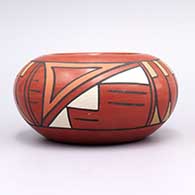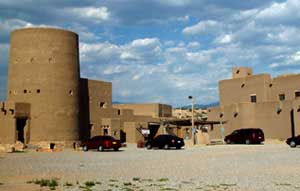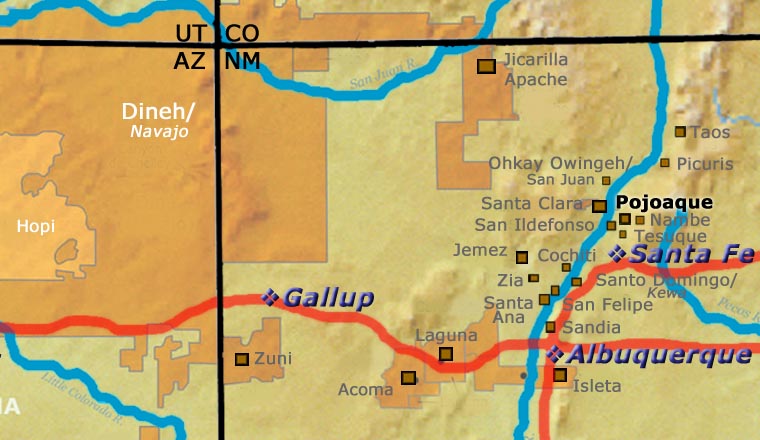
Joe and Thelma
Talachy
Pojoaque

Born in 1946, Thelma Talachy's ancestors were from Pojoaque Pueblo but she grew up at Santa Clara. After she married Joe, they chose to move to Pojoaque. Politics at Pojoaque Pueblo is different: both women and men are allowed to serve on the pueblo council and in elected positions of leadership. Thelma served three terms as Governor of the Pueblo. She also served as Lieutenant Governor, Secretary and Treasurer of the Pueblo.
Joe Talachy was born in 1940 at San Juan Pueblo (Ohkay Owingeh). Joe earned an Associates Degree in tool design at Allied Institute in Chicago, he studied business at Haskell Indian Nations College in Lawrence, KS, and served in the US Navy before they were married. After marrying, Joe had a long career at Los Alamos National Laboratory as a designer of tools and fixtures. Relaxing in their spare time, Joe and Thelma made pottery. Differently than most pottery-making couples, Joe made the pots and Thelma painted the traditional polychrome designs.
Joe, on the other hand, is the grandson of Luteria Atencio and son of Crucita Atencio Talachy, both of whom were members of the women's group who redefined San Juan/Ohkay Owingeh traditional pottery in the 1930s and began a revival of traditional pottery making on the pueblo. Joe grew up surrounded by some of the finest potters at San Juan/Ohkay Owingeh Pueblo. You know that if he wasn't making pots himself, he had his hands in the clay preparing it for his mother.
Joe and Thelma were exhibitors at the Eight Northern Pueblos Arts & Crafts Show for years, earning multiple ribbons for their work. They are no longer making pottery.
100 West San Francisco Street, Santa Fe, New Mexico 87501
(505) 986-1234 - www.andreafisherpottery.com - All Rights Reserved

Pojoaque Pueblo

Poeh Culture Center at Pojoaque
The Pojoaque Pueblo area seems to have been first settled by pithouse-dwelling Tanoans around 500 CE. A couple hundred years later and the first signs of pottery appeared. Another couple hundred years and the people were beginning to build their structures aboveground. The Tewa flooded down into the valley of the Rio Grande starting in the 1300s, and the population grew until it peaked in the late 1500s. That peak was around the same time the first Spanish arrived. After that, local populations nose-dived as European diseases and Franciscan monks wreaked collossal damage, to the point of actual genocide in some cases (none of the Piro pueblos survived after the 1680 Pueblo Revolt and none of the Tompiro pueblos survived the mid-1700s).
The first Franciscan mission was built at Pojoaque in the early 1600s but the people were already hurting under the impact of Spanish taxes, forced labor and continuous efforts to force conversion to Christianity. That all added up to Pojoaque being in the forefront of the Pueblo Revolt of 1680. Immediately following the revolt, Pojoaque was abandoned and wasn't resettled until about 1706 when many Pojoaque's trickled back from the Cuartelejo area on the plains of eastern Colorado and western Kansas. By then the major Spanish retributions had died down and it was relatively safe to return, surrender and pledge allegiance anew. Franciscans were also being replaced with Jesuits and the religious fervor receded a bit from the heights reached during the Inquisition.
The population of the reestablished pueblo grew slowly but they saw increasing problems from non-Indian encroachment until President Abraham Lincoln recognized the pueblo as an official tribe. Some documents say he awarded the tribe with an official land grant in 1864 and gave a silver cane to the tribe's governor. Other documents say the tribe was given a quit-claim deed... However it worked out, the tribe did gain some legal standing and was able to reestablish its presence until 1900 when a severe smallpox epidemic caused the pueblo to be abandoned again (the Cacique (the tribe's religious leader) died and Governor Jose Antonio Tapia left the reservation to find work).
In 1934 the Commissioner of Indian Affairs placed newspaper ads around the area calling for all Pojoaque tribal members to come back and reoccupy the pueblo lands or tribal ownership would be dissolved under the Indian Re-Organization Act. Shortly, 14 members of the Villareal, Tapia, Romero and Gutierrez/Montoya families were awarded land grants from the Pueblo land base. By 1936 tribal enrollment reached 263 members and Pojoaque became a Federally recognized Indian Reservation.
During the time of abandonment, many Pojoaque tribe members moved to nearby Santa Clara and San Juan Pueblos. Those Pojoaque who were making pottery at the time learned new things from their neighbors and when they later returned to Pojoaque, traditional pottery making changed with all the cross-pollination of styles and designs. Some potters, though, returned to making only traditional Pojoaque styles and designs. Today there is hardly any pottery being made at Pojoaque as so many tribal members are employed in one or another of the tribe's many commercial enterprises.
100 West San Francisco Street, Santa Fe, New Mexico 87501
(505) 986-1234 - www.andreafisherpottery.com - All Rights Reserved
